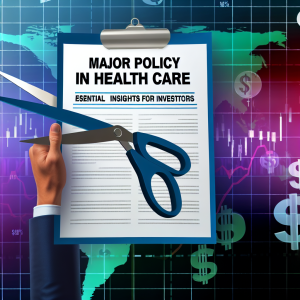The recent Senate passage of President Trump’s sweeping healthcare bill marks a pivotal moment with profound implications for millions of Americans and the healthcare system at large. While the bill’s proponents tout it as a necessary correction to inefficiencies, our analysis at Extreme Investor Network reveals a far more complex and potentially disruptive landscape for investors, healthcare providers, and policy watchers alike.
Medicaid Cuts: A Double-Edged Sword for Investors and Communities
The Congressional Budget Office (CBO) estimates that the bill slashes approximately $1.1 trillion from healthcare spending over the next decade, with Medicaid bearing the brunt—losing over $1 trillion in funding. This is not just a policy shift; it’s a seismic event for rural hospitals and healthcare providers who depend heavily on Medicaid reimbursements. According to the National Rural Health Association, over half of U.S. states could see Medicaid funding cuts exceeding 20%, threatening the viability of critical access hospitals that anchor rural economies and healthcare access.
Investor Insight: Healthcare stocks tied to rural hospital systems and Medicaid-dependent providers may face increased volatility and downside risk. Conversely, investors should monitor opportunities in telemedicine and outpatient care platforms, which could gain traction as rural patients seek alternatives amid hospital closures.
The Work Requirement: A Hidden Risk for Coverage and Economic Stability
A new national work requirement for Medicaid beneficiaries aged 19 to 64 is projected to save $325 billion over ten years but at a steep human cost. This policy mandates 80 hours per month of work, volunteering, or education to maintain coverage, disproportionately impacting older adults, seasonal workers, and those in caregiving roles. A UC Berkeley Labor Center study highlights how this could force many out of coverage due to factors beyond their control, such as health deterioration or age discrimination.
What Investors and Advisors Should Watch: This demographic shift may increase demand for alternative insurance products and supplemental coverage plans. Financial advisors should proactively counsel clients in vulnerable age brackets about potential coverage gaps and explore private insurance or health savings account (HSA) strategies as buffers.
Rural Healthcare: A System on the Brink
The bill’s provision to cap state-imposed provider taxes—used to fund Medicaid—could decimate funding streams critical to rural hospitals. Jennifer Mensik Kennedy, president of the American Nurses Association, warns of potential closures, job losses exceeding half a million, and increased health disparities. Pregnant women might face 30-40 mile drives for delivery, and emergency response times could soar, exacerbating morbidity and mortality rates.
Strategic Takeaway: Investors should scrutinize the financial health of rural healthcare providers and consider the broader economic ripple effects in rural markets. Policymakers’ $25 billion rural hospital fund is a stopgap, not a solution, signaling prolonged instability. Healthcare technology firms offering remote diagnostics and emergency response innovations could become essential players in these underserved areas.
Pharma’s Win: The ORPHAN Cures Act and Its Implications
The bill’s inclusion of the ORPHAN Cures Act exempts more rare disease drugs from Medicare price negotiations, a $5 billion boon to pharmaceutical companies over the next decade. While the biotech industry frames this as a catalyst for innovation—given that only 5% of rare diseases have approved treatments—the move draws criticism for undermining efforts to lower drug prices. Patients For Affordable Drugs Now calls this a “completely unnecessary giveaway,” highlighting the ongoing tug-of-war between industry profits and patient affordability.
Investor Angle: Pharma investors should weigh the potential for increased profits in orphan drug markets against growing political and public pressure for drug pricing reforms. This tension may fuel volatility but also drive innovation in niche therapeutic areas.
What’s Next? Actionable Steps for Investors and Advisors
-
Monitor Legislative Developments: The bill still faces hurdles in the House, where Republican divisions could reshape its final form. Stay informed on amendments that might mitigate or exacerbate Medicaid cuts.
-
Diversify Healthcare Investments: Given the risks to rural hospitals and Medicaid-dependent providers, diversify portfolios to include telehealth, outpatient care, and biotech firms focused on rare diseases.
-
Prepare Clients for Coverage Gaps: Financial advisors should educate clients about the impending Medicaid work requirements and potential loss of ACA marketplace subsidies, especially for older adults and part-time workers.
- Advocate for Policy Balance: Industry stakeholders and investors can engage in advocacy for balanced policies that protect vulnerable populations while promoting sustainable healthcare spending.
A Unique Statistic to Consider
Recent data from the CDC shows rural residents have a 15% higher prevalence of chronic diseases and a 20% higher mortality rate compared to urban populations, underscoring the critical importance of stable healthcare infrastructure in these areas. The proposed Medicaid cuts threaten to widen this gap, creating both social and economic challenges.
At Extreme Investor Network, we believe this healthcare bill is more than a political flashpoint—it’s a catalyst for profound shifts in healthcare economics and investment landscapes. Staying ahead means understanding the nuances, anticipating risks, and capitalizing on emerging opportunities in a transforming market. Keep watching this space for in-depth analysis and actionable insights as the story unfolds.
Source: How Trump bill Medicaid cuts will impact U.S. health care

